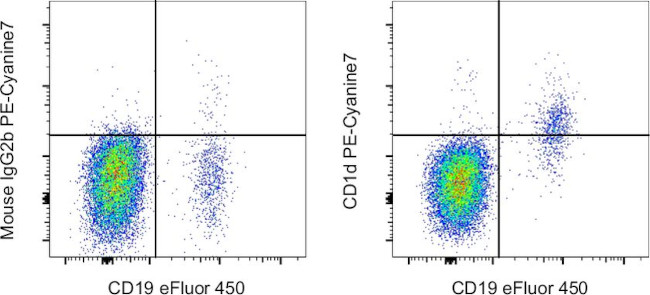Search Thermo Fisher Scientific
图: 1 / 1
CD1d Antibody (25-0016-42) in Flow

产品信息
25-0016-42
种属反应
宿主/亚型
分类
类型
克隆号
偶联物
激发/发射光谱
形式
浓度
纯化类型
保存液
内含物
保存条件
运输条件
RRID
产品详细信息
Description: The monoclonal antibody 51.1 reacts with human CD1d, a member of the CD1 family with similarity to the non-polymorphic MHC Class I-like molecules. CD1d is a highly conserved single transmembrane receptor of the Immunoglobulin Superfamily. CD1d can associate with beta-microglobulin another feature showing similarity to MHC class I molecules, but can also exist as a nonglycosylated protein not in association with beta microglobulin. This suggests different control mechanisms for presenting glycolipid containing molecules to CD1d reactive NKT cells. Expression of CD1d is found on B cells of the periphery, in resting monocytes and cortical thymocytes. On intestinal epithelial cells (IEC) expression is polarized. Expression can also be found at low levels intracellularly in hepatocytes. In HCV (hepatitis C virus) livers, CD1d is highly expressed compared to normal controls.
The 51.1 monoclonal antibody has been shown to have functional activity; blocking the interaction of CD1d transfected cells with NKT cells.
Applications Reported: This 51.1 antibody has been reported for use in flow cytometric analysis.
Applications Tested: This 51.1 antibody has been pre-diluted and tested by flow cytometric analysis of normal human peripheral blood cells. This may be used at 5 µL (0.25 µg) per test. A test is defined as the amount (µg) of antibody that will stain a cell sample in a final volume of 100 µL. Cell number should be determined empirically but can range from 10^5 to 10^8 cells/test.
Light sensitivity: This tandem dye is sensitive to photo-induced oxidation. Please protect this vial and stained samples from light.
Fixation: Samples can be stored in IC Fixation Buffer (Product # 00-8222-49) (100 µL of cell sample + 100 µL of IC Fixation Buffer) or 1-step Fix/Lyse Solution (Product # 00-5333-57) for up to 3 days in the dark at 4°C with minimal impact on brightness and FRET efficiency/compensation. Some generalizations regarding fluorophore performance after fixation can be made, but clone specific performance should be determined empirically.
Excitation: 488-561 nm; Emission: 775 nm; Laser: Blue Laser, Green Laser, Yellow-Green Laser.
靶标信息
CD1d is a heavy chain associated with Beta 2 microglobulin on cortical thymocytes. Beta 2 microglobulin independent expression of CD1d has also been demonstrated on human intestinal epithelial cells. CD1d is the sole group 2 member of the CD1 family of major histocompatibility (MHC) like glycoproteins. The CD1d gene encodes a divergent member of the CD1 family of transmembrane glycoproteins, which are structurally related to the major histocompatibility complex (MHC) proteins and form heterodimers with beta-2-microglobulin. The CD1 proteins mediate the presentation of primarily lipid and glycolipid antigens of self or microbial origin to T cells. The human genome contains five CD1 family genes organized in a cluster on chromosome 1. The CD1 family members are thought to differ in their cellular localization and specificity for particular lipid ligands. The protein encoded by the CD1d gene localizes to late endosomes and lysosomes via a tyrosine-based motif in the cytoplasmic tail. Diseases associated with CD1D include Mycobacterium Malmoense and Autoimmune Disease.
仅用于科研。不用于诊断过程。未经明确授权不得转售。
How to use the Panel Builder
Watch the video to learn how to use the Invitrogen Flow Cytometry Panel Builder to build your next flow cytometry panel in 5 easy steps.
篇参考文献 (0)
生物信息学
蛋白别名: Antigen-presenting glycoprotein CD1d; CD1d; CD1D antigen, d polypeptide; differentiation antigen CD1-alpha-3; HMC class I antigen-like glycoprotein CD1D; R3G1; T-cell surface glycoprotein CD1d; thymocyte antigen CD1D
基因别名: CD1A; CD1D; R3; R3G1
UniProt ID: (Human) P15813
Entrez Gene ID: (Human) 912




